Chapter 10
Habit 4 – talking about your feelings
Talking about your feelings and also situations can help you to manage them and give perspective. This expression of emotions is well known to be very therapeutic and also helps to stabilise the mind. This chapter looks at how to form a habit of talking through your feelings; a habit that can be learnt at any age.
•What happens when we talk about our feelings?
•What proof is there that talking helps?
•Troubleshooting
•Making time to talk
What happens when we talk about our feelings?
One habit that helps to stabilise the mind is to talk through your feelings. By expressing your feelings, the mind has the chance to do a number of things. The first is to give an opening for your Chimp to air issues that are bothering it or causing it distress. When the Chimp is allowed to vent its feelings, the Human part of the brain has a chance to listen and process what is happening. Many people know that, when they talk about their problems or ideas, they listen to themselves talking and often see things differently. What they are doing is giving their Human a chance to use logic and perspective. So when feelings are expressed, the Chimp speaks and the Human listens.
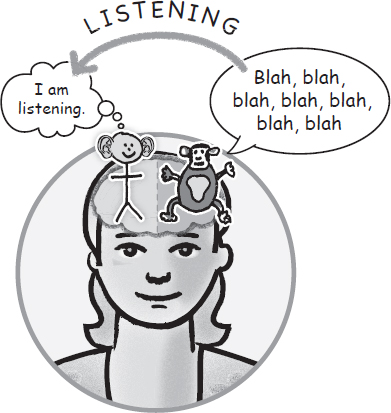
Important point
When we talk out loud, our Human listens and brings a different perspective
Children are no different to adults in needing to express their feelings. However, their Human is not very well developed and so usually they still cannot bring perspective or logic to the situation. Being the Human to a child’s Chimp is an important role for an adult who is with them. When you watch adults who are effective in helping children that are in distress, they frequently follow a sequence:
•They listen first and get a clear picture of what the child perceives is happening
•They show compassionately that they have understood the child
•They help the child to talk about their fears and remove these
•They find what conclusions the child might have reached and then alter these conclusions if they are not correct
•Finally, the adult offers ways to move forward
When I started working in child psychiatry, one of the first things to strike me was the depth of thinking that very young children are capable of. It immediately made me realise just how important it was to listen and understand what was happening in their minds. No matter what fear or conclusion the child had, I learnt to take it seriously. Children clearly welcome explanations that they can follow. Moving from working with adults to working with children had many obvious differences, but I came to appreciate that children of all ages welcome discussion, no differently to adults.
What proof is there that talking helps?
There are a number of areas that have been researched. I have selected a few of these as examples of how talking about your feelings can help you to manage them.
Talking out loud, either alone or with someone else, reduces stress levels. On the other hand, bottling things up can lead to intrusive thoughts that just won’t go away. By talking things through, it has been found that if the same stressor is met again, the person will deal with it better than the person who did not talk things through.[1] This research is based on the completion hypothesis,[2] which states that by talking we come to make sense of stressful events. During talking we create words that explain our feelings. We can then make sense of what we feel and use this to help others to understand us.
Another advantage of talking things out loud is that we rationalise events and feel less threatened. This can change the emotions that we feel towards the event.
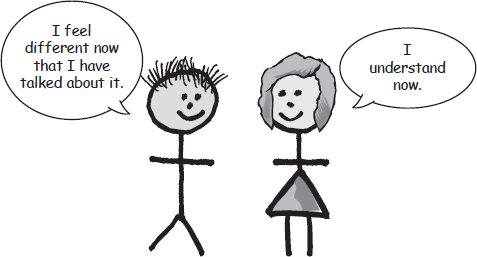
Sometimes when we talk about something that is stressing us, it can initially make us feel worse. However, if we keep talking about the situation then we usually pick up in mood and unwelcome thoughts disappear.[3]
Troubleshooting
What if a child finds it very hard to express their fears and thoughts?
Some children will find it difficult to speak about their thoughts or feelings. There can be a number of reasons for this. Here are a few suggestions for helping them to express their concerns or to talk about a distressing event. I hope you’ll find one or more that resonate.
Normalising
Everybody finds it comforting to know that what they are experiencing or how they are reacting is normal. Our Chimp brains are built to react to situations. While that isn’t always helpful, it is normal. Letting the child know that having difficulty expressing how they feel is normal and then showing them possible ways of getting through this can be comforting. Always let them know you are there with them. When possible, it is very helpful to let them know that other children have experienced what they are going through and things worked out in the end.
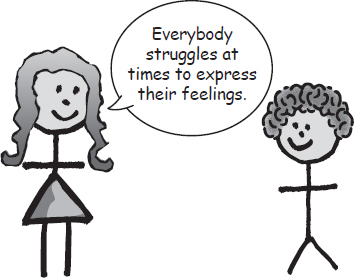
Paintings and toys
Another helpful method for a child to explain what happened or how they feel is to let them draw or paint a picture and to tell a story from the picture. The picture depicts the scene or experience that the child has experienced and they might then be able to attribute feelings to the people in the picture. Asking the child to put significant people or events in the picture will often make explaining easier. Some people use toys to enact an event.
Doing an activity while talking
Sometimes a difficult conversation can be made easier if the centre of attention is on something else and the conversation becomes secondary. By focusing on some task or activity, such as preparing a meal, going for a walk, playing with the dog or even painting or colouring a picture together, the child is likely to feel less pressured.
The best friend
Another way to allow the child to express difficult feelings is to ask what their best friend would say. The child can then tell you what their best friend would say about how they feel and about what has happened.
If the child finds this exercise difficult, an alternative is to ask them to tell a story about a boy or girl who has gone through the same experience as them. They can then answer questions on how this boy or girl felt.
Changing the situation
Sometimes asking the child what they would like to change or how they would make things different can help to get them to talk and express how they feel. Occasionally children will even tell you what they think would help and how things could get better – it’s just a question of asking them.
The triple-question option
When asking questions that might be awkward to answer, giving options and then narrowing down can be an easier way to reach difficult-to-talk-about topics. For example, let’s assume the child is worried about something at school and you suspect this but are not getting any answers. You can begin by asking them to let you know if the problem is one of the following, but not to tell you which one. Your offers could be:
•Bullying
•In trouble with the teacher
•Feeling they can’t do something
If the answer is ‘yes’ then all you have to do is eliminate the alternatives one by one. If you haven’t got a ‘yes,’ then invent three other scenarios. I have used this approach with young people and it usually works each time, as they relax.
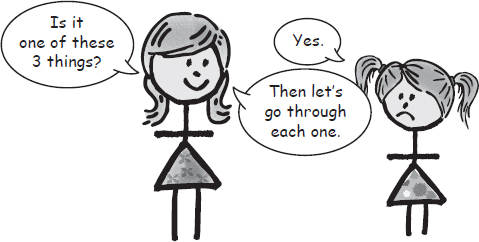
Making time to talk
There is nothing better for bringing a person closer to a child than being able to have protected talking time. For them and you this will be special. Forming a habit of talking things through will help the child to become aware of how helpful this is for getting things into perspective. If the child finds it difficult to engage then you could try asking them to keep a diary or a drawing book and to discuss what they have written or drawn for that day.
Please remember to try and ensure that you are in the right frame of mind when engaging. It is important that the time is seen as sacrosanct. Occasionally it is worth sharing your own experiences from childhood, which might help the child to realise that you might have felt the same way when you were a child.
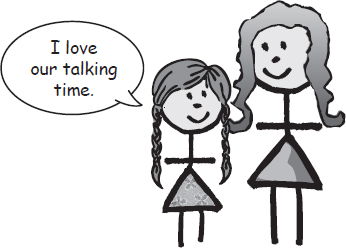
More than one conversation
Difficult topics or events can take several conversations and it’s worth limiting time so that the child can assimilate what is being discussed. Frequently the child might need to go over a topic again before they can move on. This is a time for the parent to be patient and accept that the first few discussions might not bring about any change or resolution. If the child finds it difficult to talk, then engagement can be made by first asking about more everyday things such as, ‘How was school today?’ or ‘What would you like to do this weekend?’
Managing feelings of guilt
Beating yourself up and hanging onto guilt are both very destructive habits. They often appear as the source of very low self-esteem and depressive feelings. Therefore, it is important to know how to manage any feelings of guilt. Children can suffer severely with feelings of guilt, and both children and adults can learn how to manage such feelings.
Guilt is an emotion that is experienced when we believe we have done something wrong, been negligent or could have prevented something. Guilt, therefore, is acting as a prompt to tell us that we should be doing something and not just sitting there. Guilt isn’t meant to be endured or something to become preoccupied with, but rather acted upon. There are several constructive ways to remove guilt.
Removing guilt begins by appreciating and accepting that we all make mistakes or do something wrong from time to time. This is not an excuse, but rather an understanding that we do get Chimp hijacks or just lose focus. Once we have accepted this, we can move forward. We can apologise and perform a kind or compensatory act, where possible. If we can’t put something right, one way that can help to move forward is seeing guilt as a learning point. What can you learn from the error or misdemeanour? What will be done differently in the future? We then have a better chance of preventing it from happening again.
Either way, it might take time for our own mind to process forgiveness towards ourselves.
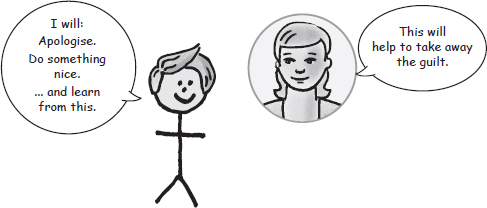
Important point
Guilt is an emotion to act on and not to endure.
If we dwell on any emotion or incident then we merely prolong the feelings and don’t move forward. Accepting that sometimes we cannot put things right is difficult. When a situation like this happens, it is important to allow yourself to grieve, and this takes time. During this grieving process it helps considerably, if possible, to talk things through.
For a child who feels guilty, the adult needs to act as their Human to bring rationality to the situation.
It helps if the adult:
•Listens and helps the child to talk
•Checks that the emotion of guilt is an appropriate one
•Brings perspective
•Rationalises the way forward
Many children find it very consoling to know that we all do things that we might regret or feel bad about. It also helps them to know that guilt can be a useful emotion to pull us in line if we are acting out of order. However, guilt is not an emotion that is useful if it is not acted upon or is inappropriate from the start. Making amends is a very helpful way to remove feelings of guilt, along with a plan of how not to allow the situation to happen again. This way we are changing our focus from the past into the future, where we can make a difference.
Summary
•Talking helps to stabilise the mind
•Like adults, children need to express their feelings
•Talking helps to rationalise events
•Protected talking time helps to bond parents and children
•Guilt is an emotion to act upon, not to endure